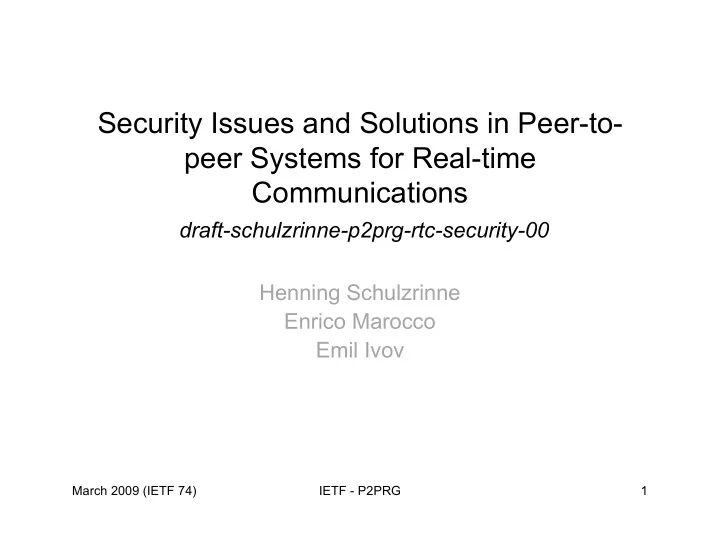

Security Issues and Solutions in Peer-to- peer Systems for Real-time Communications draft-schulzrinne-p2prg-rtc-security-00 Henning Schulzrinne Enrico Marocco Emil Ivov March 2009 (IETF 74) IETF - P2PRG 1
Overview • Attacker motivations • Attacker resources • P2P for real-time (vs. file sharing) – more than just a DHT March 2009 (IETF 74) IETF - P2PRG 2
Attacker motivations • Disrupt communications – extortion, dislike, political, … – incumbent operator? • Financial gain – impersonation – theft of service – spamming (SPIT) • Fun & fame March 2009 (IETF 74) IETF - P2PRG 3
Attacker resources • Identities: – IP addresses • if used for DHT position • user subscription limitations – mobile phone #’s – email addresses, … • Computational resources – botnets make proof-of-work largely useless March 2009 (IETF 74) IETF - P2PRG 4
Attack timing March 2009 (IETF 74) IETF - P2PRG 5
Review: P2P for real-time • Map names to other identifiers – sip:alice@example.com alice@128.59.16.1 • Provide (computational) services – proxying (registration, services) – relaying (NAT traversal) • Store data – configuration data – voicemail March 2009 (IETF 74) IETF - P2PRG 6
File sharing vs. real time File sharing Real-time Distributed database file location User locations: one per hundreds or thousands user per user Availability same file, hundreds of each user is unique copies Integrity poison file store with impersonate user bogus material but no compromise user direct threat to user communication integrity Confidentiality Files are public Communications is (may want to hide origin) private (src/dest & content) March 2009 (IETF 74) IETF - P2PRG 7
Admission control • Goal: keep rogue percentage low – allows detection, voting, bypassing • Group charter + group authority – authority certifies candidates compliance with charter – central authority or voting • how practical in semi-anonymous systems? • what information can votes be based on? • ballot stuffing by compromised nodes • Use CAPTCHA to reduce impact of bots • RELOAD (and Skype) uses central authority March 2009 (IETF 74) IETF - P2PRG 8
Position in overlay • Sybil attacks do not depend on identifier – but preventing nodes from choosing location randomizes attacks • IP address or identifier provided by central authority – IP address doesn’t work well for NATed devices – Allows attacker more choice • Use temporary identifiers? – randomizes attack targets • Use diametrically opposed IDs to avoid local collusion – rogue nodes can add neighbors March 2009 (IETF 74) IETF - P2PRG 9
Identifying malicious peers • Proactive – use test cases to detect misbehavior – “mystery shopper” • Reactive – detect and report misbehavior • Reputation management – mostly investigated for file sharing – difficult to prevent another denial-of-service attacks of rogue nodes – transitive trust March 2009 (IETF 74) IETF - P2PRG 10
Real-time services are different • Don’t need everyone to be a peer – just enough resources to get job done – just increases routing latency (log(N)) – increases chances of corruption • Typically, promote nodes from clients to peers – use invitation, rather than self-promotion – based on uptime, resources, public IP address, geographic need • Why would a client want to become peer? – Skype: closed (almost) no choice – Open systems: incentives randomized promotion for sybil prevention March 2009 (IETF 74) IETF - P2PRG 11
Attack • Denial of service – black hole signaling or media – fictitious error responses (“no such number”) – use iterative routing – getting closer? • Integrity of location bindings – Identity-based crypto non-intuitive identifiers • Integrity of content (voice mail, …) – generally, only inserter needs access March 2009 (IETF 74) IETF - P2PRG 12
Summary (& my take) • P2P systems for real-time applications ≠ file sharing – more than just key value mapping • Identity scarcity is crucial – leverage existing hard-to-clone identities • Reputation systems are unlikely to work – either central entity knows “good guys” – or they all look the same • Avoiding centralization at all cost may not matter for real- time services – typically, don’t have Napster/PirateBay problem March 2009 (IETF 74) IETF - P2PRG 13
Recommend
More recommend